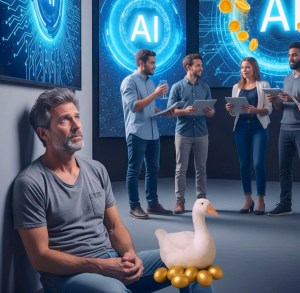Founders with great businesses are often frustrated that they can’t raise money.
Here’s why.
I’ve been having coffee with lots of frustrated founders (my students and others) bemoaning most VCs won’t even meet with them unless they have AI in their fundraising pitch. And the AI startups they see are getting valuations that appear nonsensical. These conversations brought back a sense of Déjà vu from the Dot Com bubble (at the turn of this century), when if you didn’t have internet as part of your pitch you weren’t getting funded.
I realized that most of these founders were simply confused, thinking that a good business was of interest to VCs. When in fact VCs are looking for extraordinary businesses that can generate extraordinary returns.
In the U.S., startups raising money from venture capitalists are one of the engines that has driven multiple waves of innovation – from silicon, to life sciences, to the internet, and now to AI. However, one of the most frustrating things for founders who have companies with paying customers to see is other companies with no revenue or questionable technology raise enormous sums of cash from VCs.
Why is that? The short answer is that the business model for most venture capital firms is not to build profitable companies, nor is it to build companies in the national interest. VCs’ business model and financial incentives are to invest in companies and markets that will make the most money for their investors. (If they happen to do the former that’s a byproduct, not the goal.) At times that has them investing in companies and sectors that won’t produce useful products or may cause harm but will generate awesome returns (e.g. Juul, and some can argue social media.)
Founders looking to approach VCs for investment need to understand the four forces that influence how and where VCs invest:
1) how VCs make money, 2) the Lemming Effect, 3) the current economic climate and 4) Secondaries.
How VCs Make Money
Just a reminder of some of the basics of venture capital. Venture is a just another financial asset class – with riskier investments that potentially offer much greater returns. A small number of a VC investments will generate 10x to 100x return to make up for the losses or smaller returns from other companies. The key idea is that most VCs are looking for potential homeruns, not small (successful?) businesses.
Venture capital firms are run by general partners who raise money from limited partners (pension funds, endowments, sovereign wealth funds, high-net-worth individuals.) These limited partners expect a 3x net multiple on invested capital (MOIC) over 10 years, which translates to a 20–30% net internal rate of return (IRR). After 75 years of venture investing VC firms still can’t pick which individual company will succeed so they invest in a portfolio of startups.
VCs seesaw between believing that a winning investment strategy is access to the hottest deals (think social media a decade ago, AI today), versus others believing in the skill of finding and investing in non-obvious winners (Amazon, Airbnb, SpaceX, Palantir.)  The ultimate goal of a VC investment is to achieve a successful “exit,” such as an Initial Public Offering (IPO) or acquisition, or today on a secondary, where they can sell their shares at a significant profit. Therefore, the metrics for their startups was to create the highest possible market cap(italization). A goal was to have a startup become a “unicorn” having a market cap of $1billion or more.
The ultimate goal of a VC investment is to achieve a successful “exit,” such as an Initial Public Offering (IPO) or acquisition, or today on a secondary, where they can sell their shares at a significant profit. Therefore, the metrics for their startups was to create the highest possible market cap(italization). A goal was to have a startup become a “unicorn” having a market cap of $1billion or more.
The Lemming Effect
VCs most often invest as a pack. Once a “brand-name” VC invests in a sector others tend to follow. Do they somehow all see a disruptive opportunity at the same time, or is it Fear Of Missing Out (FOMO)? (It was years after my company Rocket Science Games folded that my two investors admitted that they invested because they needed a multi-media game company in their portfolio.) Earlier in this century the VC play was fuel cells, climate, food delivery, scooters, social media, crypto, et al. Today, it’s defense and AI startups. Capital floods in when the sector is hot and dries up when the hype fades or a big failure occurs.
The current economic climate
In the 20th century the primary path for liquidity for a VC investment in a startup (the way they turned their stock ownership in a startup into dollars) meant having the company “go public” via an initial public offering (IPO) on a U.S. stock exchange. Back then underwriters required that the company had a track record of increasing revenue and profit, and a foreseeable path to do so in the next year. Having your company bought just before the IPO was a tactic for a quick exit but was most often the last resort at a fire sale price if an IPO wasn’t possible.
Beginning with the Netscape IPO in 1995 and through 2000, the public markets began to have an appetite for Internet startups with no revenue or profits. These promised the next wave of disruption. The focus in this area became eyeballs and clicks versus revenue. Most of these companies crashed and burned in the dotcom crash and nuclear winter of 2001-2003, but VC who sold at the IPO or shortly after made money.
For the last two decades IPO windows have briefly opened (although intermittently) for startups with no hope for meaningful revenue, profit or even deliverable products (fusion, quantum, etc. heavy, infrastructure-scale moonshots that require decades to fruition). Yet with company and investor PR, hype and the public’s naivete about deep technology these companies raised money, their investors sold out and the public was left hanging with stock of decreasing value.
Today, the public markets are mostly closed for startup IPOs. That means that venture capital firms have money tied up in startups that are illiquid. They have to think about other ways to get their money from their startup investments.
Secondaries
Today with the Initial Public Offering path for liquidity for VCs mostly closed, secondaries have emerged as a new way for venture firms and their limited partners to make money.
Secondaries allow existing investors (and employees) to sell stock they already own – almost always at a higher price than their purchase price. These are not new shares and don’t dilute the existing investors. (Some VC funds can sell a stake in their entire fund if they want an early exit.) Secondaries offer VC funds a way to take money off the table and reduce their exposure.
The game here is that startups and their investors need to continually hype/promote their startup to increase the company’s perceived value. The new investors – later stage funds, growth equity firms, hedge funds or dedicated secondary funds, now have to do the same to make money on the secondary shares they’ve purchased.
What Do These Forces Mean For Founders?
- Most VCs care passionately about the industry they invest in. And if they invest in you they will do anything to help your company succeed.
- However, you need to remember their firm is a business.
- While they might like you, think you are extraordinarily talented, they are giving you money to make a lot more money for themselves and their investors (their limited partners.)
- See my painful lesson here when I learned the difference between VC’s liking you, versus their fiduciary duty to make money.
- The minute you take money from someone their business model becomes yours.
- If you don’t understand the financial engineering model a VC firm is operating under, you’re going to be an ex CEO.
- You need to understand the time horizon, size, scale of the returns they are looking for.
- Some companies, while great businesses may not be venture fundable.
- Can yours provide a 10 to 100x return? Is it in (or can it create) a large $1B market?
- VC funds tend to look for a return in 7-10 years.
- Is your team extraordinary and coachable?
- VCs tend to be either followers into hot deals and sectors or are looking for undiscovered big ideas.
- Understand which type of investor you are talking to. Some firms have a consistent strategy; in others there may be different partners with contrary opinions.
- Storytelling matters. Not only does it matter, but it’s an integral part of the venture capital game.
- If you cannot tell a great credible story that matches the criteria for a venture scale investment you’re not ready to be a venture funded CEO.
- If you’re lucky enough to have an AI background, grab the golden ring. It won’t be there forever.
Filed under: Venture Capital |










